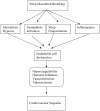Sleep-disordered breathing and cardiovascular disorders
- PMID: 20875159
- PMCID: PMC2972194
Sleep-disordered breathing and cardiovascular disorders
Abstract
Compelling data demonstrate a strong association between sleep-disordered breathing (SDB) and cardiovascular disorders. The association is most consistent between obstructive sleep apnea (OSA) and hypertension. Epidemiologic and clinic-based studies provide evidence for an etiological role of OSA in hypertension, independent of obesity. Furthermore, several studies suggest amelioration of hypertension with therapy for sleep apnea. Emerging data also suggest a role for OSA in causing coronary artery disease. This association is bolstered by evidence suggesting that continuous positive airway pressure (CPAP) therapy improves early signs of atherosclerosis and may impede progression to clinically important cardiovascular disease. SDB (both OSA and central sleep apnea) is frequently observed in patients with heart failure. OSA may be a risk factor for incident heart failure. The current data do not provide consistent evidence for whether treatment of SDB will improve survival or other end points in patients with heart failure, and larger trials are currently underway to better elucidate that relationship. Substantial evidence also links SDB to an increased risk of various arrhythmias. Treatment of SDB with CPAP appears to significantly attenuate that risk. Finally, several studies suggest SDB as a risk factor for stroke. Whether treatment of SDB reduces stroke risk, however, remains to be determined. In conclusion, persuasive data provide evidence for an association, probably causal, between sleep-disordered breathing and several cardiovascular disorders. Large randomized controlled trials will further help confirm the association and elucidate the cardiovascular benefits of SDB therapy.
Figures
References
-
- Tishler PV, Larkin EK, Schluchter MD, Redline S. Incidence of sleep-disordered breathing in an urban adult population: the relative importance of risk factors in the development of sleep-disordered breathing. Jama. 2003;289(17):2230–7. - PubMed
-
- Fletcher EC. The relationship between systemic hypertension and obstructive sleep apnea: facts and theory. Am J Med. 1995;98(2):118–28. - PubMed
-
- Franklin KA, Nilsson JB, Sahlin C, Naslund U. Sleep apnoea and nocturnal angina. Lancet. 1995;345(8957):1085–7. - PubMed
-
- Hung J, Whitford EG, Parsons RW, Hillman DR. Association of sleep apnoea with myocardial infarction in men. Lancet. 1990;336(8710):261–4. - PubMed
-
- Malone S, Liu PP, Holloway R, Rutherford R, Xie A, Bradley TD. Obstructive sleep apnoea in patients with dilated cardiomyopathy: effects of continuous positive airway pressure. Lancet. 1991;338(8781):1480–4. - PubMed
Publication types
MeSH terms
Grants and funding
LinkOut - more resources
Full Text Sources
Medical

